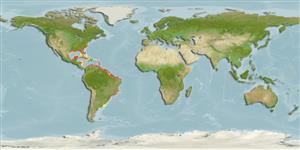>
Carangiformes (Jacks) >
Carangidae (Jacks and pompanos) > Caranginae
Etymology: Hemicaranx: Greek, hemi = the half + French, carangue, the name of a Caribbean fish; 1836 (Ref. 45335).
More on author: Cuvier.
Environment: milieu / climate zone / depth range / distribution range
Écologie
marin; profondeur ? - 50 m (Ref. 9626). Subtropical; 37°N - 41°S, 98°W - 34°W
Western Atlantic: North Carolina, USA and northern Gulf of Mexico southward to Florianópolis, Brazil; not found in most parts of the Lesser Antilles (Ref. 9626). Also found in Uruguay (Ref. 54736) and Argentina (Ref. 2806).
Taille / Poids / Âge
Maturity: Lm ? range ? - ? cm
Max length : 50.0 cm TL mâle / non sexé; (Ref. 26340); common length : 25.0 cm TL mâle / non sexé; (Ref. 5217)
Épines dorsales (Total) : 8; Rayons mous dorsaux (Total) : 27; Épines anales: 3; Rayons mous anaux: 23.
Adults are coastal species. They do not form large schools (Ref. 35237). Juveniles are encountered in brackish estuaries (Ref. 5217), moving to greater depths as it grows, but not deeper than 50 m (Ref. 9626). Eggs are pelagic, spawning occurs generally in summer (Ref. 35237). Marketed fresh (Ref. 9626).
Life cycle and mating behavior
Maturité | Reproduction | Frai | Œufs | Fécondité | Larves
Robins, C.R. and G.C. Ray, 1986. A field guide to Atlantic coast fishes of North America. Houghton Mifflin Company, Boston, U.S.A. 354 p. (Ref. 7251)
Statut dans la liste rouge de l'IUCN (Ref. 130435: Version 2024-1)
Menace pour l'homme
Harmless
Utilisations par l'homme
Pêcheries: intérêt commercial mineur
Outils
Articles particuliers
Télécharger en XML
Sources Internet
Estimates based on models
Preferred temperature (Ref.
123201): 22.9 - 28, mean 25.6 °C (based on 474 cells).
Phylogenetic diversity index (Ref.
82804): PD
50 = 0.5625 [Uniqueness, from 0.5 = low to 2.0 = high].
Bayesian length-weight: a=0.01122 (0.00514 - 0.02450), b=3.04 (2.87 - 3.21), in cm total length, based on all LWR estimates for this body shape (Ref.
93245).
Niveau trophique (Ref.
69278): 3.9 ±0.3 se; based on diet studies.
Résilience (Ref.
120179): Milieu, temps minimum de doublement de population : 1,4 à 4,4 années (Preliminary K or Fecundity.).
Fishing Vulnerability (Ref.
59153): Moderate vulnerability (40 of 100).
Nutrients (Ref.
124155): Calcium = 95.3 [52.2, 207.3] mg/100g; Iron = 1.65 [0.91, 3.08] mg/100g; Protein = 20.1 [18.9, 21.3] %; Omega3 = 0.401 [0.248, 0.679] g/100g; Selenium = 19 [10, 37] μg/100g; VitaminA = 10.8 [3.5, 32.7] μg/100g; Zinc = 0.719 [0.503, 1.061] mg/100g (wet weight);
